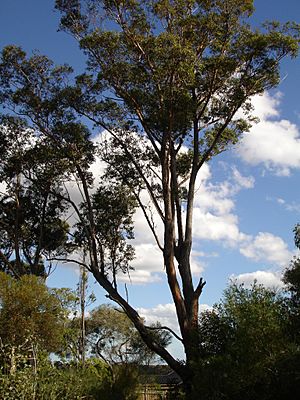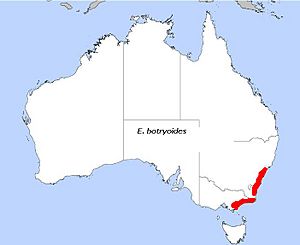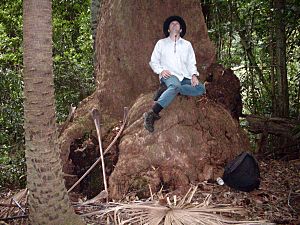Bangalay facts for kids
Quick facts for kids Bangalay, Southern Mahogany |
|
|---|---|
 |
|
| Eucalyptus botryoides, Melbourne | |
| Scientific classification | |
| Genus: |
Eucalyptus
|
| Species: |
botryoides
|
 |
|
| E. botryoides, field distribution | |
The Eucalyptus botryoides, also called Bangalay, Southern Mahogany, or Woollybutt, is a tree from southeastern Australia. It can grow very tall, up to 40 meters (about 130 feet) high. This tree has rough bark on its trunk and branches.
You can find it growing in open forests on rocky or sandy soils. It often grows near the coast behind sand dunes. Its white flowers bloom in summer and autumn. After a bushfire, it can regrow from a special woody base called a lignotuber or from hidden buds under its bark. Sometimes, it mixes with other gum trees like the Sydney blue gum. Its strong wood is used for things like floors and wall panels.
Contents
About the Bangalay Tree
Bangalay trees can grow very straight and tall, up to 40 meters (130 feet) high. Their trunk can be as wide as 1 meter (3 feet) across at chest height. In windy coastal areas, they might be shorter, around 6 to 12 meters (20 to 40 feet) tall. Here, their leaves form a thick, bushy top.
Sometimes, in very sandy soil, they grow as a "mallee" form. This means they have many thin trunks instead of one main one. The tree has a big, woody base called a lignotuber. This base can be up to 6 meters (20 feet) wide!
The bark on the trunk and big branches is thick and rough. It has deep grooves and can be flaky. This bark is usually grey-brown, but it can be reddish-brown near the coast. Smaller branches have smooth, pale grey bark.
Leaves, Flowers, and Fruits
Adult Bangalay leaves have stalks and are shaped like a spear. They are about 10 to 16 cm (4 to 6 inches) long and 2 to 6 cm (1 to 2 inches) wide. The top side is dark green, and the bottom side is paler. You can see many fine veins on the leaves.
The white flowers appear from January to April. They grow in small groups of six to eleven. These flowers develop from small, club-shaped buds. After the flowers, the tree produces woody fruits, which are also called gumnuts. These gumnuts are oval or cylinder-shaped. They are about 7 to 12 mm long and 4 to 6 mm wide.
Young Bangalay plants have different leaves. Their leaves are more oval and grow opposite each other on the stem. They are also paler underneath. As the plant grows, the leaves change to the adult shape and grow alternately.
Tree Family and History
The Bangalay tree was first described by a scientist named James Edward Smith in 1797. Its scientific name, botryoides, comes from an Ancient Greek word meaning "cluster." This might be because its flowers and fruits grow in clusters.
Scientists classify the Bangalay with other "red mahoganies." Its closest relatives include the red mahogany and the swamp mahogany. In the Sydney area, Bangalay trees sometimes mix with Sydney blue gum trees. This creates new types of hybrid trees.
Where Bangalay Trees Live

Bangalay trees grow along the coast of southeastern Australia. You can find them from near Newcastle in New South Wales down to eastern Victoria. They mostly grow in sandy soils or soils made from sandstone. These soils are often found behind coastal sand dunes or in river valleys.
These trees usually grow close to the ocean, but not directly in saltwater. They prefer low-lying areas, from sea level up to about 300 meters (1,000 feet) high. They need areas that get 700 to 1300 mm (28 to 51 inches) of rain each year.
Neighbours in the Forest
Bangalay trees often grow with other trees in open forests. Some of their tree neighbours include turpentine, spotted gum, blackbutt, and Sydney blue gum. In wetter forests, you might also see lillypilly and wattle trees growing nearby.
Near sand dunes, Bangalay trees grow with shorter white stringybark and silvertop ash trees. You might also see plants like banksias and burrawang. In wetlands, Bangalay trees grow with blackbutt, grey ironbark, and different types of banksias. The understory plants in these areas include various rushes and tea-trees.
How Bangalay Trees Survive
Bangalay trees are very good at surviving bushfires. After a fire, they can regrow from special buds hidden under their bark. They can also regrow from their woody lignotuber base. Some Bangalay trees have been found to be 600 years old!
Interestingly, if a branch breaks off, it can sometimes grow roots and start a new tree. This happens because the thick, rough bark can hold water, which helps the branch sprout roots.
Koalas sometimes eat the leaves of the Bangalay tree. Ants also enjoy the nectar from its flowers. However, these trees can get sick from tiny insects called psyllids.
Uses of Bangalay Wood
The wood from the center of the Bangalay tree is very strong and heavy. It is similar to the wood from Sydney blue gum trees. Because it is so durable, it is often used for making floors and wall panels in buildings.
- Features of the bangalay (Eucalyptus botryoides)
See also
 In Spanish: Bangalay para niños
In Spanish: Bangalay para niños








